
Friday, May 23, 2008
New track lay-out
To be able to use the spirals the trains need to drive upwards with the smallest slope possible. This is the outside track. This meant the spirals had to be on the other side which is changed in this lay-out.


Sunday, May 18, 2008
Test spiral
Mainly to see how this is really done but also to test what some "authorities" in model railroad building are saying, I build a small test spiral this weekend. Before anything else I must say that this spiral will only be used by trains consisting of max. 5 cars including a locomotive.
It's N-scale. The curves are R1 and R2 and there are 5 cm's between levels. The outer track has an incline of 3.8% and the inner track has an incline of about 4.5% (which is why we drive up along the outside as that has the smallest incline).
The spiral was made from 3 mm thick MDF panels. This is really thin but surprisingly stiff when fixed properly!
During this build, a few things went wrong which is good so I won't do it again when building the real thing later.
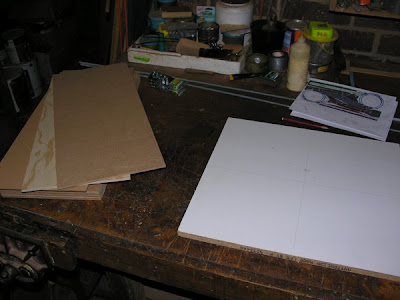 Start with cutting the biggest pieces of wood. I was going to try several kinds of wood but the 3 mm MDF worked so well that I didn't bother trying the others. The white panel is 18 mm thick melamine crap wood.
Start with cutting the biggest pieces of wood. I was going to try several kinds of wood but the 3 mm MDF worked so well that I didn't bother trying the others. The white panel is 18 mm thick melamine crap wood.
I made a giant compass to draw all the circles required to build the spiral on the white panel. After you draw the circles, mark the points where a rod is going to be.
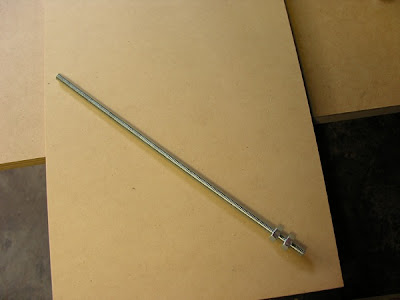 To fix the different levels, get some threaded steel rod. Make sure it's nice and smooth and clean thread. I had to go back to buy new ones. After I cut the first ones up I noticed how crap they were and that you couldn't put a nut on it without using heavy machinery...
To fix the different levels, get some threaded steel rod. Make sure it's nice and smooth and clean thread. I had to go back to buy new ones. After I cut the first ones up I noticed how crap they were and that you couldn't put a nut on it without using heavy machinery...
 Mount all the cut rods firmly.
Mount all the cut rods firmly.
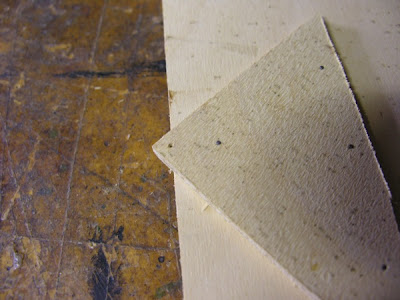 Because the edge of a panel is in the middle of a circle you can't position the compass properly. I made a little helper out of scrap wood.
Because the edge of a panel is in the middle of a circle you can't position the compass properly. I made a little helper out of scrap wood.
 Place one panel tight against the helper and draw your circles on the panel. As the spiral goes up, the diameter of the circles should be a little bit bigger than what you drew on the white panel. The formula for this is the Pythagoras formula: A^2 = B^2 + C^2. So if the diameter of the outside of the spiral track is 50 and it goes up 2.5 cm (!!! HALF of the spiral distance of 5 cm in my case !!!) you should use a diameter of sqr(2500 + 6.25) = 50.1. This may look too little to bother with but it works a lot nicer when things fall in place well instead of forced.
Place one panel tight against the helper and draw your circles on the panel. As the spiral goes up, the diameter of the circles should be a little bit bigger than what you drew on the white panel. The formula for this is the Pythagoras formula: A^2 = B^2 + C^2. So if the diameter of the outside of the spiral track is 50 and it goes up 2.5 cm (!!! HALF of the spiral distance of 5 cm in my case !!!) you should use a diameter of sqr(2500 + 6.25) = 50.1. This may look too little to bother with but it works a lot nicer when things fall in place well instead of forced.
 If all goes well you end up with a lot of circles. Inside and outside of the spiral and circles for rod positions.
If all goes well you end up with a lot of circles. Inside and outside of the spiral and circles for rod positions.
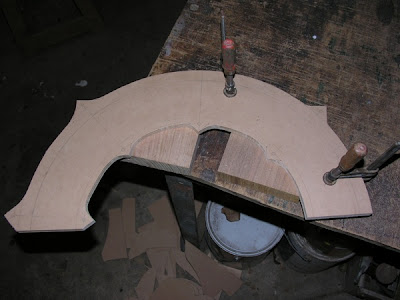 When that's done, cut out the half tracks.
When that's done, cut out the half tracks.
 Now the best part can begin: Building the actual spiral. Fix the spiral track on the rods between 2 nuts. I had to fix the bottom with a nail because it wouldn't go down. Possibly due to a miscalculation (I used the whole 5 cm instead of 2.5 cm when calculating new diameters...)
Now the best part can begin: Building the actual spiral. Fix the spiral track on the rods between 2 nuts. I had to fix the bottom with a nail because it wouldn't go down. Possibly due to a miscalculation (I used the whole 5 cm instead of 2.5 cm when calculating new diameters...)
 Build the spiral further.
Build the spiral further.
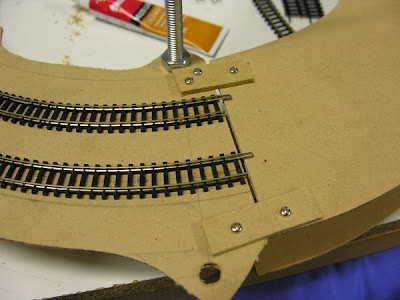 spiral tracks may have to be fixed to each other to make them even.
spiral tracks may have to be fixed to each other to make them even.
 Do bit by bit, including the track because you can't really reach well.
Do bit by bit, including the track because you can't really reach well.
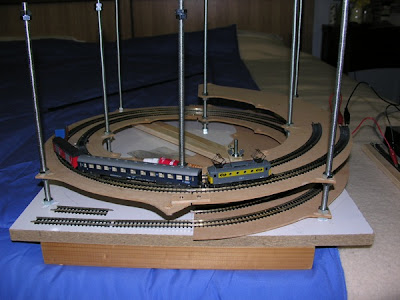 And when it's finished, test it by running a train up and down. Here's my little NS 1100 pulling a few cars without any trouble.
And when it's finished, test it by running a train up and down. Here's my little NS 1100 pulling a few cars without any trouble.
 Here my NS 1200 pulls 3 cars up the spiral without much effort.
Here my NS 1200 pulls 3 cars up the spiral without much effort.
I have to say though, my little glasskasten has a lot more trouble going up the hill.
It's N-scale. The curves are R1 and R2 and there are 5 cm's between levels. The outer track has an incline of 3.8% and the inner track has an incline of about 4.5% (which is why we drive up along the outside as that has the smallest incline).
The spiral was made from 3 mm thick MDF panels. This is really thin but surprisingly stiff when fixed properly!
During this build, a few things went wrong which is good so I won't do it again when building the real thing later.
I made a giant compass to draw all the circles required to build the spiral on the white panel. After you draw the circles, mark the points where a rod is going to be.
I have to say though, my little glasskasten has a lot more trouble going up the hill.
Saturday, May 17, 2008
Giant compass
Test circuit
I have put together a test board of my power supply and it works pretty good. I may do a bit of fine-tuning so I'm not posting the circuit yet but it is something like this with a few modifications. The heat sink this guy uses seems way too small unless he's using a separate circuit to detect overheating but he doesn't speak about that...
 Based around the good old 723 voltage regulator.
Based around the good old 723 voltage regulator.
 The multi meter is also finally paying off :-)
The multi meter is also finally paying off :-)
 Another close up. Breadboard fun...
Another close up. Breadboard fun...
Tuesday, May 13, 2008
First table design
I'm looking for a place where I can see and enjoy my model trains but I don't want it to take up part of or a whole room. I want it to be a static display but also dynamic. It has to be technically challenging in lots of different ways. It should be fun and functional and also it should look good because my girlfriend is not into model trains so it may not be in her way ;-)
So I'm going to make a coffee table model railroad.
I tried this before but it was a shonky quick and dirty job so now we're going to prepare better starting with designing the track layout and now the table itself.
 This is the first attempt in designing the table. It will also get a glass top. The cylinders will hold the rail coil on the outside and the inside will not be covered by glass, leaving an opening for i.e. a plant. It has yet to be decided what kind of "feet" the table will get...
This is the first attempt in designing the table. It will also get a glass top. The cylinders will hold the rail coil on the outside and the inside will not be covered by glass, leaving an opening for i.e. a plant. It has yet to be decided what kind of "feet" the table will get...
The design tool used by the way, is Sketchup from Google.
So I'm going to make a coffee table model railroad.
I tried this before but it was a shonky quick and dirty job so now we're going to prepare better starting with designing the track layout and now the table itself.
 This is the first attempt in designing the table. It will also get a glass top. The cylinders will hold the rail coil on the outside and the inside will not be covered by glass, leaving an opening for i.e. a plant. It has yet to be decided what kind of "feet" the table will get...
This is the first attempt in designing the table. It will also get a glass top. The cylinders will hold the rail coil on the outside and the inside will not be covered by glass, leaving an opening for i.e. a plant. It has yet to be decided what kind of "feet" the table will get...The design tool used by the way, is Sketchup from Google.
Subscribe to:
Posts (Atom)
